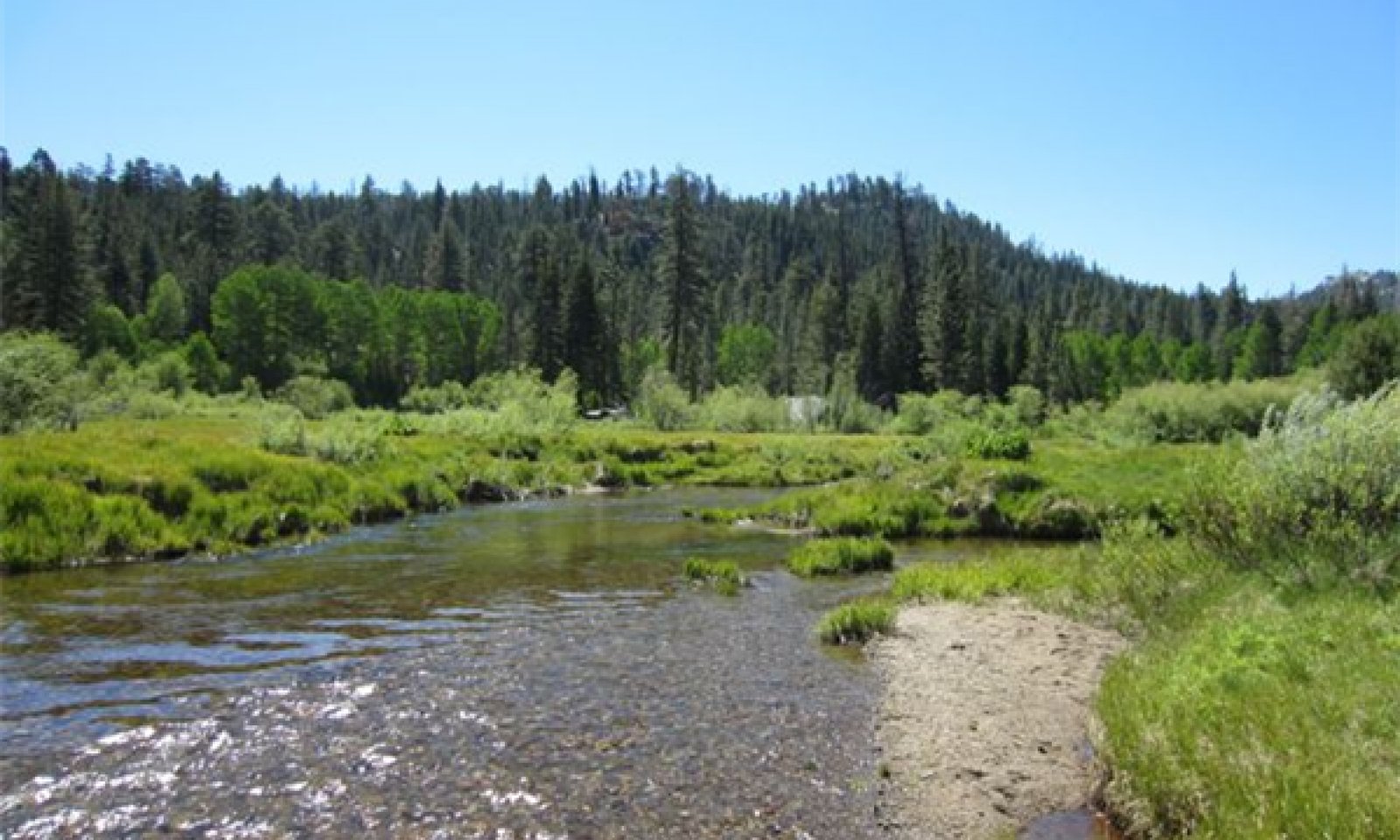

Natural Resources
Conservation Service
Ecological site R022AX107CA
Frigid C Channel System
Accessed: 12/21/2025
General information
Provisional. A provisional ecological site description has undergone quality control and quality assurance review. It contains a working state and transition model and enough information to identify the ecological site.
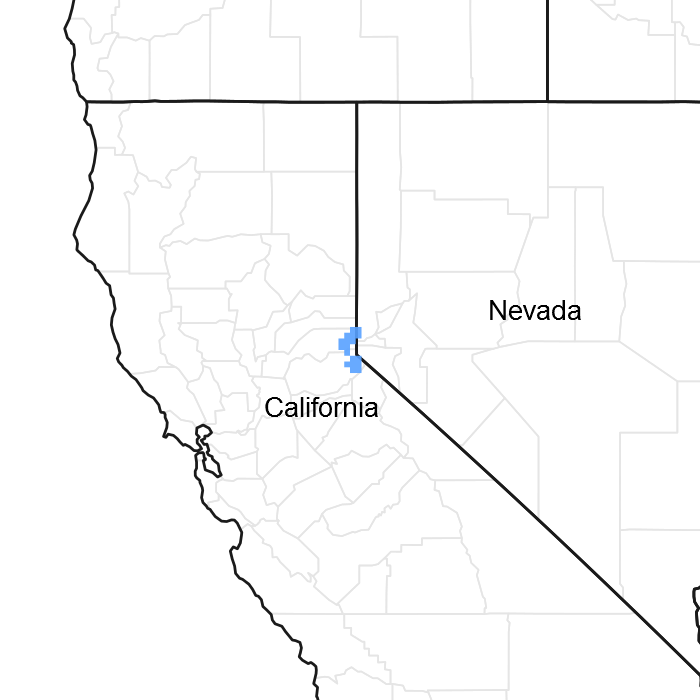
Figure 1. Mapped extent
Areas shown in blue indicate the maximum mapped extent of this ecological site. Other ecological sites likely occur within the highlighted areas. It is also possible for this ecological site to occur outside of highlighted areas if detailed soil survey has not been completed or recently updated.
MLRA notes
Major Land Resource Area (MLRA): 022A–Sierra Nevada and Tehachapi Mountains
Major Land Resource Area 22A, Sierra Nevada Mountains, is located predominantly in California and a small section of western Nevada. The area lies completely within the Sierra Nevada Section of the Cascade-Sierra Mountains Province. The Sierra Nevada range has a gentle western slope, and a very abrupt eastern slope. The Sierra Nevada consists of hilly to steep mountains and occasional flatter mountain valleys. Elevation ranges between 1,500 and 9,000 ft throughout most of the range, but peaks often exceed 12,000 ft. The highest point in the continental US occurs in this MLRA (Mount Whitney, 14,494 ft). Most of the Sierra Nevada is dominated by granitic rock of the Mesozoic age, known as the Sierra Nevada Batholith. The northern half is flanked on the west by a metamorphic belt, which consists of highly metamorphosed sedimentary and volcanic rocks. Additionally, glacial activity of the Pleistocene has played a major role in shaping Sierra Nevada features, including cirques, arêtes, and glacial deposits and moraines. Average annual precipitation ranges from 20 to 80 inches in most of the area, with increases along elevational and south-north gradients. Soil temperature regime ranges from mesic, frigid, and cryic. Due to the extreme elevational range found within this MLRA, Land Resource Units (LRUs) were designated to group the MLRA into similar land units.
Major Land Resource Area 22A, Sierra Nevada Mountains, is located predominantly in California and a small section of western Nevada. The area lies completely within the Sierra Nevada Section of the Cascade-Sierra Mountains Province. The Sierra Nevada range has a gentle western slope, and a very abrupt eastern slope. The Sierra Nevada consists of hilly to steep mountains and occasional flatter mountain valleys. Elevation ranges between 1,500 and 9,000 ft throughout most of the range, but peaks often exceed 12,000 ft. The highest point in the continental US occurs in this MLRA (Mount Whitney, 14,494 ft). Most of the Sierra Nevada is dominated by granitic rock of the Mesozoic age, known as the Sierra Nevada Batholith. The northern half is flanked on the west by a metamorphic belt, which consists of highly metamorphosed sedimentary and volcanic rocks. Additionally, glacial activity of the Pleistocene has played a major role in shaping Sierra Nevada features, including cirques, arêtes, and glacial deposits and moraines. Average annual precipitation ranges from 20 to 80 inches in most of the area, with increases along elevational and south-north gradients. Soil temperature regime ranges from mesic, frigid, and cryic. Due to the extreme elevational range found within this MLRA, Land Resource Units (LRUs) were designated to group the MLRA into similar land units.
Classification relationships
This ecological site has similarities with the Warm willow/Gravel Bar Ecological Type described in the Eastern Sierra Nevada Riparian Field Guide (Weixelman et al. 1999).
Ecological site concept
This site typically occurs in gentle reaches where meadows are associated with the stream. B type channels are typically present in reaches between meadows in more confined areas. Community components include a pioneer forb-mixed willow community on frequently flooded gravel bars and floodplains, a Lemmon’s willow (Salix lemmonii)- mixed sedge community on the floodplains, a tufted hairgrass (Deschampsia cespitosa) upland grass community, and Sierra lodgepole pine (Pinus contorta var. murrayana) community on the terraces or abandoned floodplains.
This ecological site describes a C type channel that typically occurs with an associated meadow. As this ecological site is currently mapped, portions of this area are upland dry meadows without a true stream channel. These systems are not described in this ESD. These areas should be developed as a new ESD. This ecological site also occurs as a minor component in 26 mapunits. B type channels are typical for these minor components. These systems are not described in this ESD, and should be developed as a new ESD. In order to develop these ESDs, additional soil, vegetation and cross-section data is needed, and well as an update to the soil mapunits, components, and soil map.
Associated sites
| F022AE007CA |
Frigid, Sandy, Moraines And Hill Slopes This ecological site occurs on moraines with a white fir (Abies concolor) Jeffrey pine (Pinus jeffreyi) forest. |
|---|---|
| F022AE008CA |
Frigid Loamy Moraine Slopes This ecological site occurs on volcanic moraines with a white fir (Abies concolor), Jeffrey pine (Pinus jeffreyi, and red fir (Abies magnifica) forest. |
| F022AE013CA |
Frigid, Loamy, Volcanic Mountain Slopes This ecological site occurs on volcanic coluvium, with a white fir (Abies concolor) mixed conifer forest. |
| F022AE025CA |
Loamy Moist Outwash This ecological site occurs on outwash and gentle toe slopes of moraines. It occurs along the valley bottoms adjacent to this riparian ecological site. It has a lush white fir (Abies concolor)- Jeffrey pine (Pinus jeffreyi forest. |
| F022AF001CA |
Frigid Sandy Outwash Plain Gentle Slopes This ecological site occurs on outwash with a cemented till layer. Vegetation is open Sierra lodgepole pine (Pinus contorta var. murrayana) and western juniper (Juniperus grandis), with a diverse understory. |
| R022AE217CA |
Frigid Volcanic Slopes This ecological site occurs on volcanic mountain slopes, with moderately deep soils. Montane shrubs and forbs are dominant. |
| R022AX102CA |
Frigid E-C Meadow System This ecological site may occur in the same mapunit as this riparian site. It occurs on smaller, very low gradient, E to C type channels. |
Similar sites
| R022AX105CA |
Steep Mountain Drainageways This ecological site occurs on steep (typically greater than 5%) headwater and first order drainageways. |
|---|---|
| R022AA102CA |
Alpine Bedrock Benches This ecological site occurs on smaller, lower gradient E to C channels, with a broad meadow, often dominated by sedges. |
Table 1. Dominant plant species
| Tree |
Not specified |
|---|---|
| Shrub |
(1) Salix lemmonii |
| Herbaceous |
(1) Arnica chamissonis |
Physiographic features
This site is on floodplains, alluvial flats and outwash terraces. Slopes range from 0 to 5 percent, but slope of less than 2 percent are typical. Elevations range from 6,220 to 7,730 feet.
Table 2. Representative physiographic features
| Landforms |
(1)
Flood plain
(2) Valley flat (3) Outwash terrace |
|---|---|
| Flooding duration | Very long (more than 30 days) |
| Flooding frequency | None to frequent |
| Ponding duration | Very long (more than 30 days) |
| Ponding frequency | None to frequent |
| Elevation | 6,220 – 7,730 ft |
| Slope | 5% |
| Ponding depth | 12 in |
| Water table depth | 30 in |
| Aspect | Aspect is not a significant factor |
Climatic features
The average annual precipitation is 23 to 61 inches, mostly in the form of snow in the winter. The average annual air temperature is 41 to 65 degrees Fahrenheit, and the frost-free season is 20 to 75 days. The freeze-free (>28F) season is 40 to 110 days. The monthly data below is from the Tahoe, California climate station listed below. This station is the closest to this ecological site in elevation and distance; however, this climate station, which is located near Tahoe City, CA, may receive more precipitation than is typical for this ecological site. The monthly precipitation data below represent the average total monthly precipitation. The frost-free and freeze-free data are from the Ward Creek Snotel data.
Table 3. Representative climatic features
| Frost-free period (average) | 47 days |
|---|---|
| Freeze-free period (average) | 75 days |
| Precipitation total (average) | 42 in |
Figure 2. Monthly average minimum and maximum temperature
Figure 3. Annual precipitation pattern
Figure 4. Annual average temperature pattern
Influencing water features
This ecological site is associated with a Rosgen C type channel.
Soil features
The Tahoe, Tahoe wet phase, Tahoe gravelly phase, Tahoe drained phase, Watah and Marla soils are associated with this ecological site. These soils are associated with different fluvial surfaces, and vary in wetness and organic matter accumulation. These soils are all very deep, and formed in alluvium from granitic or mixed granitic and volcanic parent material. These soils are very poorly drained with slow to moderately rapid (Marla) permeability. The soil moisture regime is aquic and the soil temperature regime is frigid. Surface and subsurface rock fragments are typically absent, but the Tahoe gravelly phase has up to 15 percent gravels in the subsurface, and the Watah soils may have 25 percent gravels in one horizon.
Soils by fluvial surface:
CC1, Active floodplains, gravel bars
The Tahoe gravelly phase (Coarse-loamy, mixed, superactive, acid, frigid Cumulic Humaquepts) is associated with this component. It has a mucky gravelly silt loam surface texture. The subsurface textures are gravelly loam to gravelly loamy fine sand to gravelly fine sand. Mottles are at 3 inches, and gleyed conditions begin at 30 inches. CC1 is associated with this component.
CC2, Floodplains, frequently flooded
The Tahoe wet phase is associated with this component. The Tahoe, silt loam wet phase component is frequently flooded or ponded for very long durations, with a flooding or ponding depth up to 15 inches deep. CC2 is associated with this soil component. The Watah (coarse-loamy, mixed, superactive, acid, frigid Histic Humaquepts) soils are of limited extent in this ecological site, but may also occur on the floodplain. The Watah soils develop in the wettest locations, in broad low-lying areas typically in an old backwater area. The Watah soils have 20 to 40 cm of peat or mucky peat, developed primarily from decomposed sedge roots. Below the organic horizons the soil is sandier with gravelly mucky coarse sandy loam and gravelly loamy coarse sand textures. Gleyed soil colors occur below 73 cm. The Watah soils are frequently flooded or ponded for very long durations with up to 15 inches of water. Community component 1 (CC2) is also associated with the Watah soils.
CC3, Floodplain step, occasionally flooded
The Tahoe soil is associated with this community. It is occasionally flooded and ponded for brief to long durations during spring and early summer. The Tahoe component is occasionally flooded or ponded for brief to long durations, with a ponding or flooding depth up to 6 inches deep. CC3 is associated with this soil component.
CC4, Outwash terrace
The Marla (sandy, mixed, frigid Aquic Dystroxerepts) soils occur on outwash terraces that occur on the edge of the valley or meadow, and are influenced by the ground water hydrology of the meadow. The surface textures are loamy coarse sand and subsurface textures are loamy coarse sand and clay loam. The Marla soils are associated with CC4.
This ecological site occurs as a major component in the following mapunit in the Lake Tahoe Basin.
Map unit;Map unit name; Component; Phase; Percent
7042;Tahoe complex, 0 to 5 percent slopes, gravelly;Tahoe;gravelly;557042;Tahoe complex, 0 to 5 percent slopes, gravelly;Tahoe;gravelly wet;25
7043;Tahoe mucky silt loam, drained, 0 to 5 percent slopes;Tahoe;Drained;80
This ecological site is also correlated with a 1 to 5 percent, Tahoe gravelly, component in 23 additional mapunits within the Lake Tahoe Basin.
Table 4. Representative soil features
| Parent material |
(1)
Alluvium
–
granite
|
|---|---|
| Surface texture |
(1) Mucky silt loam (2) Loamy coarse sand (3) Peaty |
| Family particle size |
(1) Sandy |
| Drainage class | Very poorly drained to poorly drained |
| Permeability class | Slow to moderately rapid |
| Soil depth | 60 in |
| Surface fragment cover <=3" | Not specified |
| Surface fragment cover >3" | Not specified |
| Available water capacity (0-40in) |
5.1 – 7.3 in |
| Soil reaction (1:1 water) (0-40in) |
4 – 5.8 |
| Subsurface fragment volume <=3" (Depth not specified) |
25% |
| Subsurface fragment volume >3" (Depth not specified) |
Not specified |
Ecological dynamics
This riparian complex is associated with alluvial fill valley (VIII) or Glacial Trough (V) valley types, which have been influenced by till and outwash. This site naturally develops a Rosgen C channel type, with potential to develop unstable G, F, or D channel types.
This site typically occurs in gentle reaches where meadows are associated with the stream. B type channels are typically present in reaches between meadows in more confined areas. Community components include a pioneer forb-mixed willow community on frequently flooded gravel bars and floodplains, a Lemmon’s willow-mixed sedge community on the floodplains, a tufted hairgrass upland grass community, and Sierra lodgepole pine community on the terraces or abandoned floodplains.
The Tahoe soil series is the dominant soil that occurs on the floodplains associated with this ecological site. The Tahoe soils have a rich surface horizon with mucky silt loam textures from organic matter accumulation. Typically there are buried soil horizons, with mucky silt loam, coarse sand, or sandy loam textures. Depth of the buried horizons varies, but the upper buried horizon is typically around 20 inches below the surface. Gleyed soil colors begin at 30 to 45 inches. The Watah soils are present in the wettest, most stable areas, where thick organic matter has accumulated. The Watah soils have 38 cm of peat over gravelly sandy loam and gravelly coarse sand. If peat dries out, due to altered hydrology, it will start to decay and become susceptible to trampling, and subsequent erosion due to water or wind erosion.
Hydrologic factors:
These streams have been heavily impacted, and historic stream conditions are difficult to find. Less impacted areas exhibit eroded C type channels, within alternating reaches of D type, F and entrenched C type channels. Beavers have impacted channel morphology in some areas.
A C type channel is a slightly entrenched single thread meandering channel with a well-defined floodplain. The channel has moderate to high sinuosity with less than two percent channel gradient. These channel types generally have a width to depth ratio greater than 12, which means they are wide and shallow. They are often found in broad valleys with well-developed alluvial floodplains and terraces. These channels typically flood over bank two years out of three. In an undegraded state, a 50-year flood event should overflow onto the floodplain. C type channels are constantly in the process of transporting and storing sediments from upstream sources or bank erosion. As the particle size of the channel bottom material decreases, the sediment supply generally increases and so does the erosion potential. The channels on this site support gravel (C4) reaches, which have very high erosion potentials, and are very sensitive to disturbance. Vegetation, such as willow and sedges exert a very high controlling influence on C type channel dynamics (Rosgen 1994).
C type channels respond quickly to disturbances, which may cause channel aggradation, channel incision, or bank erosion. This can shift a C type channel to unstable D, G or F type channels. C type channels can become unstable due to disturbances that impact stream bank vegetation, change the flow regime, or alter channel morphology. Overgrazing and excessive trampling by livestock can reduce streambank stability by reducing the vegetative cover or by physically trampling the banks. Continued disturbance can cause the stream to erode and incise deeper into the alluvial sediments, containing high flows within the channel, and reducing or eliminating overbank flows onto the floodplain. The incision and stream confinement creates a deep, narrow, eroded G type channel. Overtime, the G type channel is widened by bank erosion, and a wide, entrenched F type channel develops. These channels (“G” and “F”) generally lose the wetland obligate species because the water table is lower and flow disconnected from the floodplain. The floodplains associated with G and F type channels become dominated by upland grass, shrub and/or forest plant communities. The banks are often bare due to active erosion. As the F channel obtains sufficient width, erosive scour is reduced, vegetation can establish on the banks and along the greenline. Channel meander and point bar development occurs in the entrenched channel, allowing a new entrenched C type channel to develop. The entrenched channel supports wetland plant communities but it is constrained by terraces to the lower floodplain where a lower water table supports a greater proportion of upland plants.
Disturbance Factors:
During the mid-1800’s approximately 80 percent of the forests in Tahoe were clear-cut during the Comstock era (Elliott-Fisk et al. 1996). The removal of the trees increased erosion on mountain slopes and increased sediment supply to these river systems. The removal of trees would also have reduced water loss to evapotranspiration and increased water flow into the streams. The side effects of the logging era on stream morphology are unknown, but likely increased sediment supply and stream volume in these systems. Davis (1996) report increased erosion between 1850 and 1900 based on analysis of cores from Lake Tahoe. The erosion was attributed to logging, grazing and road development during this period. During the same period, there was an increase in Pediastrum a genus of algae, and an increase in sedge (Carex spp.) pollen, possibly due to increased nutrient loading into the lake and tributaries.
The meadows in the Lake Tahoe Basin were grazed in the past by cattle and sheep. Over 13 dairy farms were active in the basin, and most meadows were fenced for cattle grazing. Sheep roamed the mountains, and denuded much of the forbs and grasses (Elliott-Fisk et al. 1996). Cattle concentrate in riparian habitats because of access to water, forage, shade and gentle landscapes (Kie and Boroski 1996). The cattle may have affected the present composition of vegetation by selectively grazing palatable species and trampling susceptible species. Grazing can affect channel morphology by removing bank stabilizing vegetation, such as willows, and by trampling the stream banks with their hooves when accessing the stream. Fine sediment and nutrient loading (which increases algal growth) are currently the primary factors attributed to reduced lake clarity in Lake Tahoe Basin (Lahontan Water Board and Nevada Division of Environmental Protection 2008).
Road development and other infrastructure development has reduced the meander and meander belt width in several reaches, creating a stream with more concentrated flow, and scour potential.
Large flood events can cause immediate and drastic changes in channel morphology. Large areas may be subject to thick layers of sedimentation, which often cause the channel to braid. In other areas, meander bends may be cut off, a new channel created, or flows may scour the banks, eroding floodplains or terraces.
Beavers are present in these streams, but typically build dams on side channels or braided areas where flow is not concentrated. Beavers were once thought to be non-native to the Sierra Nevada, but carbon dating of old beaver dams has shown that beavers were in the Sierra Nevada since AD 580 (James and Lanman 2012, Landman et al. 2012). Beaver trapping and extirpation efforts eliminated beavers from the higher Sierra Nevada by mid-1800s. Beavers were reintroduced into the Lake Tahoe Basin from 1939 to 1949 (Beier and Barrett 1987) after 100 years or more of absence. Nine beavers were introduced from the Snake River in Idaho to the Truckee River. Since then populations have expanded to many watersheds around Lake Tahoe. In 1987 there were 0.72 colonies (3.5 beavers) per km of stream along the Truckee River (Beier and Barrett 1987).
Beavers develop dams to create deeper water for mobility, safety, and den building (Beier and Barrett 1987). Dam building raises the water table above the dam, causing pond development and flooding across the floodplain. Below the beaver dam, or after dams are removed, the channel may become unstable and scour or widen depending upon the site. The historic impact of beaver on this site is unknown, but they likely influenced the development of these streams and meadows. Their absence may have contributed to increased erosion as historic dams decayed or washed out releasing sediment, increasing flow velocity, lowering water tables, causing channel stabilizing sedges to decline.
Ecological sites associated with lotic stream systems are developed using channel evolution models. Stream systems are dynamic and continually evolve to reach a stable equilibrium. Streams develop identifiable stages of development based on channel morphology (Rosgen 1997). These stages are identified using a state and transition model based on stream evolution models.
The reference state is typically the pre-settlement, most successionally advanced and hydrologically stable community phase (numbered 1.1), and the community phases that result from natural and human disturbances. Community phase 1.1 is deemed the phase representative of the most successionally advanced pre-European plant/animal community including beaver activity and hydrologic conditions that influence its composition and production. Because this phase is partly determined from reconstruction and/or historic literature, some speculation is necessarily involved in describing it.
All tabular data listed for a specific community component within this ecological site description represent a summary of one or more field data collection plots taken in modal communities within the community component. Although such data are valuable in understanding the community component (kinds and amounts of ground and surface materials, canopy characteristics, community phase overstory and understory species, production and composition, and growth), they do not represent the absolute range of characteristics or an exhaustive listing of all species that may occur in that phase over the geographic range of the ecological site.
State and transition model

Figure 5. R022AX107CA STM
More interactive model formats are also available.
View Interactive Models
More interactive model formats are also available.
View Interactive Models
Click on state and transition labels to scroll to the respective text
State 1 submodel, plant communities
State 2 submodel, plant communities
State 3 submodel, plant communities
State 1
Reference State
This state is the reference state for this ecological site. It is defined by a Rosgen C channel type.
Community 1.1
C Channel

Figure 6. C Channel
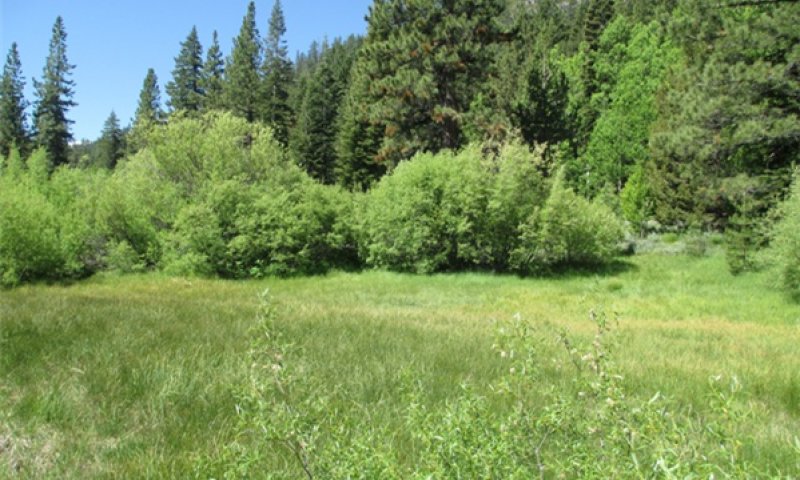
Figure 7. CC2
This phase is defined by a stable C type channel system. Data was not obtainable for this phase, but community components are described based on observations in areas that have been less impacted by modifications. The photo for this phase is situated below a large and persistent beaver pond. The beaver ponds create a very high water table, which is not always present. CC1, Active floodplain This community component occurs on active floodplains and gravel bars. Data is lacking for this community in this state, but it may not have been as abundant historically prior to channel disturbances. It is found in areas with recent scour or deposition, and is presently dominated by pioneer forbs and willows. Historically, these areas may have been more stable, with mat forming sedges, such as Northwest territory sedge (Carex utriculata), Nebraska sedge (Carex nebrascensis) and water sedge (Carex aquatlis). CC2, Floodplain This community occurs on adjacent broad floodplains, where a Lemmon's willow and mixed sedge community is present. This community is more often ponded than flooded, and may receive water from springs or side channels that contribute to a higher water table. Presently this community is difficult to find in unaltered conditions with a high water table. Overall cover of sedges may have declined, and forbs and grasses may be establishing in the canopy openings. CC3, Floodplain step This community occurs on the drier meadow edges, but on rich alluvial soils. Tufted hairgrass was most likely dominant in the past, but in state 2 CC2 mountain rush is typically dominant, with chamisso arnica (Arnica chamissonis), and sticky cinquefoil (Potentilla glandulosa). CC4, Outwash This community occurs on outwash bordering the meadow or stream. Sierra lodgepole pine is present with sparse Lemmon’s willow, Woods’ rose (Rosa woodsii var. ultramontana), whitestem gooseberry (Ribes inerme var. inerme), blue wildrye (Elymus glaucus), Kentucky bluegrass (Poa pratensis) and other species depending upon the disturbance history, microtopography, and depth to water table.
State 2
Unstable Channels
This state is composed of unstable D, G and F type channel phases.
Community 2.1
D channel
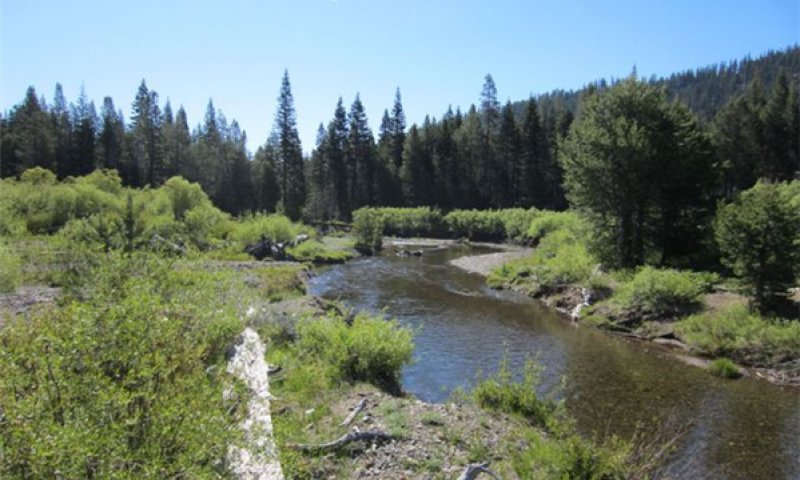
Figure 8. D Channel
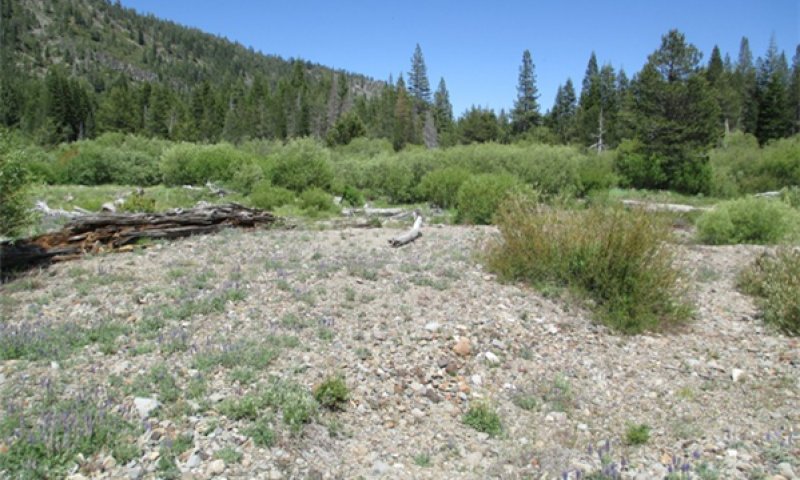
Figure 9. Gravel Bar
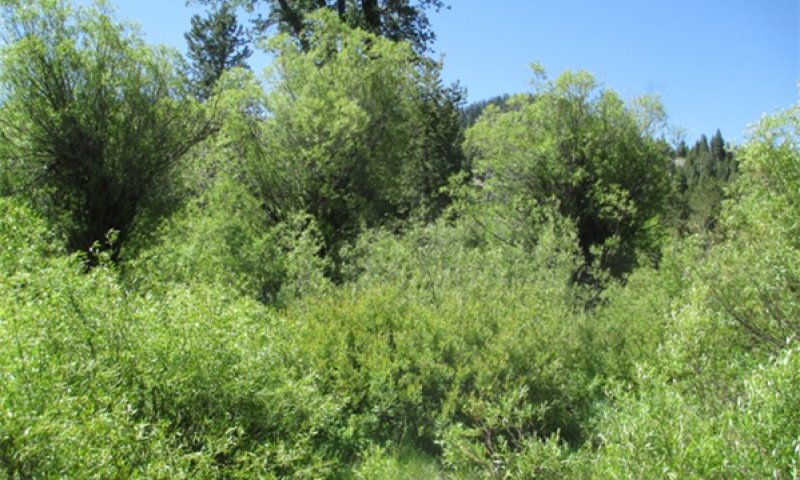
Figure 10. CC1
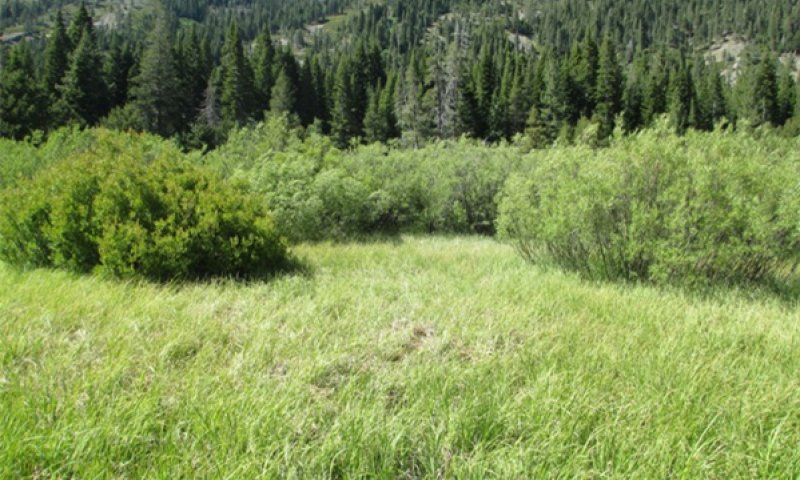
Figure 11. CC2
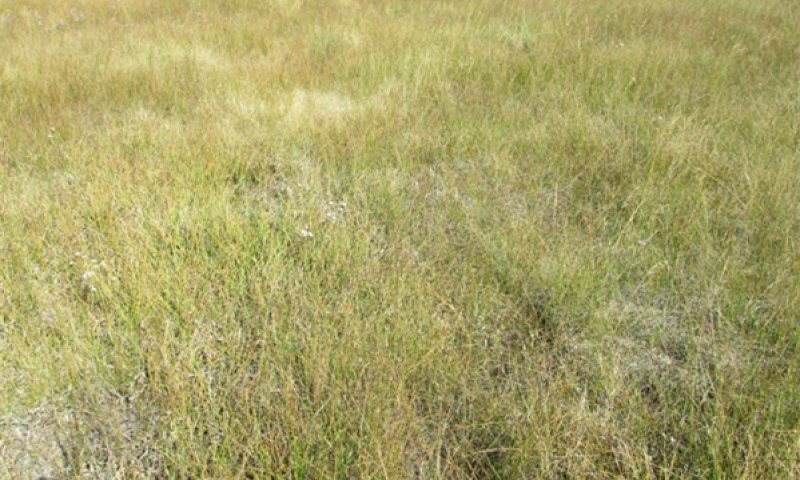
Figure 12. CC3
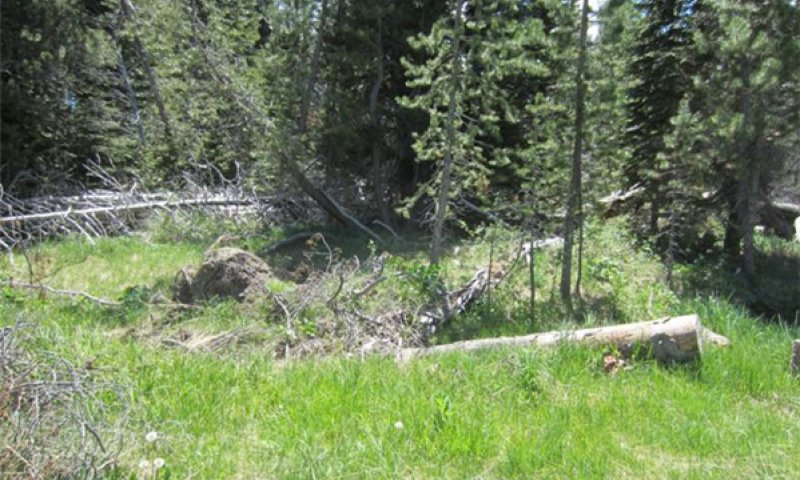
Figure 13. CC4
The D channel phase is characterized by channel aggradation and development of braided channels. This phase has a notable increase in bare or sparsely vegetated gravel deposits. CC1, Gravel bar, active floodplain This community component occurs on active floodplains and gravel bars subject to frequent burial or erosion. Lemmon’s willow and shining willow (Salix lucida) can sprout and establish from broken stems that get buried in flood deposits. Willows are also tolerant of stem breakage from flood debris and sediments. Pioneer forbs dominate on early succession phase on gravel bars, such as Pacific lupine (Lupinus lepidus), naked buckwheat (Eriogonum nudum), silverleaf phacelia (Phacelia hastata), common yarrow (Achillea millefolium), Douglas' sagewort (Artemisia douglasiana), thickstem aster (Eurybia integrifolia), Holboell's rockcress (Arabis holboellii), scarlet gilia (Ipomopsis aggregata), and clover (Trifolium sp.). This community has a diversity of annual and perennial forbs. As the willows establish, they capture fine sediments from gentler flood episodes, and accumulate organic matter over time. Canopy cover of willows increases, and cover and diversity of forbs and grass and grass-likes increases. In more stable areas, forbs include nettleleaf giant hyssop (Agastache urticifolia), western pearly everlasting (Anaphalis margaritacea), fireweed (Chamerion angustifolium ssp. circumvagum), Mt. Hood pussypaws (Cistanthe umbellata var. umbellata), fringed willowherb (Epilobium ciliatum), field horsetail (Equisetum arvense), spurry buckwheat (Eriogonum spergulinum), bastardsage (Eriogonum wrightii), common cowparsnip (Heracleum maximum) , bigleaf lupine (Lupinus polyphyllus), starry false lily of the valley (Maianthemum stellatum), wild mint (Mentha arvensis), purple monkeyflower (Mimulus lewisii), primrose monkeyflower (Mimulus primuloides), Parish's yampah (Perideridia parishii), slender cinquefoil (Potentilla gracilis), garden sorrel (Rumex acetosa), waxy checkerbloom (Sidalcea glaucescens), Oregon checkerbloom (Sidalcea oregana ssp. spicata), Canada goldenrod (Solidago Canadensis), woollyhead parsnip (Sphenosciadium capitellatum), Fendler's meadow-rue (Thalictrum fendleri), stinging nettle (Urtica dioica), and California false hellebore (Veratrum californicum). Common grass and grass-likes include, California brome (Bromus carinatus), Nebraska sedge, other sedges (Carex spp.), blue wildrye (Elymus glaucus), fescue (Festuca spp.), meadow barley (Hordeum brachyantherum), alpine timothy (Phleum alpinum), and Kentucky bluegrass (Poa pratensis). Other shrubs include, purpleflower honeysuckle (Lonicera conjugialis), twinberry honeysuckle (Lonicera involucrata), whitestem gooseberry, and MacKenzie's willow (Salix prolix). Sierra lodgepole pine, black cottonwood (Populus balsamifera ssp. trichocarpa), and quaking aspen (Populus tremuloides) may also be present. CC2, Floodplain This community occurs on more stable positions, where flooding is more diffuse, soils are more developed, and water tables are higher (partially due to side drainages or seeps). Lemmon's willow, shining willow, Geyer willow (Salix geyeriana) are common, with whitestem gooseberry in the understory of the willows. Other shrubs that may be present on the drier edges are Saskatoon serviceberry (Amelanchier alnifolia) and wax currant (Ribes cereum). Nebraska sedge or Northwest Territory sedge are typically dominant, but as the side be domes drier or more disturbed other grasses and forbs establish in the canopy opening of the declining sedges. Common grass and grass-likes include western needlegrass (Achnatherum occidentale), brome (Bromus sp.), tufted hairgrass, blue wildrye, mountain rush (Juncus arcticus ssp. littoralis), Sierra rush (Juncus nevadensis), straightleaf rush (Juncus orthophyllus), Kentucky bluegrass, and Sandberg bluegrass (Poa secunda). Forbs include common yarrow, Pacific onion (Allium validum), western columbine (Aquilegia formosa), Chamisso arnica, Douglas' sagewort, Virginia strawberry (Fragaria virginiana), largeleaf avens (Geum macrophyllum), Sierra stickseed (Hackelia nervosa), common cowparsnip, Brewer's lupine (Lupinus breweri), starry false lily of the valley, wild mint, sticky cinquefoil, slender cinquefoil (Potentilla gracilis), and Oregon checkerbloom, Canada goldenrod (Solidago Canadensis). CC3, Floodplain step This community occurs on the drier meadow edges. Tufted hairgrass and mountain rush are often dominant in this community, with few shrubs. Forbs include common yarrow, Chamisso arnica, Douglas' sagewort, spurry buckwheat, spreading groundsmoke (Gayophytum diffusum), pinewoods horkelia (Horkelia fusca), Pacific lupine, Rydberg's penstemon (Penstemon rydbergii), meadow bistort (Polygonum bistorta), Douglas' knotweed (Polygonum douglasii), sticky cinquefoil, and curvepod yellowcress (Rorippa curvisiliqua). Other grass and grass-likes include brome, sedge, slender hairgrass (Deschampsia elongate), rushes (Juncus spp.), pullup muhly (Muhlenbergia filiformis) and mat muhly (Muhlenbergia richardsonis). CC4, Outwash This community occurs on outwash bordering the meadow or stream. Sierra lodgepole pine is present with sparse Lemmon’s willow, Woods’ rose, whitestem gooseberry, blue wildrye (Elymus glaucus), Kentucky bluegrass (Poa pratensis), and mountain rush. Other species that may be present include other sedges, straightleaf rush, fireweed, sweetcicely (Osmorhiza berteroi), sticky cinquefoil, longleaf starwort (Stellaria longifolia), western mountain aster (Symphyotrichum spathulatum), Saskatoon serviceberry, and wax currant.
Figure 14. Annual production by plant type (representative values) or group (midpoint values)
Table 5. Annual production by plant type
| Plant type | Low (lb/acre) |
Representative value (lb/acre) |
High (lb/acre) |
|---|---|---|---|
| Grass/Grasslike | 50 | 150 | 1500 |
| Shrub/Vine | 60 | 900 | 1250 |
| Forb | 30 | 150 | 320 |
| Tree | 0 | 45 | 150 |
| Total | 140 | 1245 | 3220 |
Community 2.2
G Channel
This phase is typically a transitional phase, as flow is concentrated in a narrow and deep channel. The water table lowers as it flows to the incised channel. This channel typically quickly widens to an F type channel. CC1 This community develops and matures on the old gravel bars of the D channel. As vegetation increases in cover and litter accumulates, soil development continues. CC2 This community is impacted by the lowering of the water table, causing sedge production to decline. Grasses and forbs become more abundant. CC3 This community also declines in production. Grass and forb cover is lower, and Sierra lodgepole pine and Kentucky bluegrass may increase. CC4 This community may have a decline in cover of willows, Wood’s rose, and an increase in Kentucky bluegrass.
Community 2.3
F Channel

Figure 15. F Channel
This phase is defined by a wide, deeply incised F type channel. The communities are similar as described in the G type channel.
Pathway 2.1a
Community 2.1 to 2.2
This pathway occurs when flow is concentrated into the channel, causing erosion and incision through the sediments, creating a G type channel.
Pathway 2.2a
Community 2.2 to 2.3
This pathway occurs with lateral erosion of the stream banks that creates a wide and shallow F type channel.
State 3
Re-established Stable Channels
This state is defined by a stable, entrenched C channel.
Community 3.1
Entrenched C Channel
This phase is defined by an entrenched C channel. Meander, point bar development, and floodplains allow for the dispersal of flow. Vegetation establishes and further stabilizes the banks. As the new lower floodplains develop, there will be a new narrow floodplain that can support the water table dependent species in CC1 and CC2. However, these communities will remain at a much lower extent than prior to channel incision. CC3 and CC4 will remain on the upper abandoned floodplains.
Transition T1A
State 1 to 2
This transition occurs when the C type channel equilibrium is disrupted. This may be triggered by the loss of channel stabilizing vegetation, either from physical trampling or hydrological alterations that cause the water table to lower and subsequently cause a decline in the stabilizing vegetation. Manipulations such as channel straightening, confining the floodplain, or improperly designed road crossings can also trigger this transition.
Restoration pathway R2A
State 2 to 1
Restoration to State 1 may require channel reconstruction, creating greater meander and meander belt widths. In some cases the elevation of the channel bed may need to be raised. Upland erosion may need to be taken into account to reduce sediment supply. Restoration efforts have been completed and are ongoing in these areas, including the upper Truckee River, and Blackwood Canyon.
Transition 2.1A
State 2 to 3
This transition occurs when the F channel has widened sufficiently to allow for a C channel type to develop with a lower re-established floodplain.
Restoration pathway 3.1A
State 3 to 1
Restoration to State 1 will involve channel reconstruction. See restoration 2.1A.
Additional community tables
Table 6. Community 2.1 plant community composition
| Group | Common name | Symbol | Scientific name | Annual production (lb/acre) | Foliar cover (%) | |
|---|---|---|---|---|---|---|
|
Tree
|
||||||
| 1 | Active floodplain | 0–90 | ||||
| Sierra lodgepole pine | PICOM | Pinus contorta var. murrayana | 0–30 | 0–2 | ||
| black cottonwood | POBAT | Populus balsamifera ssp. trichocarpa | 0–30 | 0–2 | ||
| quaking aspen | POTR5 | Populus tremuloides | 0–30 | 0–2 | ||
| 4 | Outwash | 10–150 | ||||
| Sierra lodgepole pine | PICOM | Pinus contorta var. murrayana | 10–150 | 2–35 | ||
|
Shrub/Vine
|
||||||
| 1 | Active floodplain | 950–1250 | ||||
| Lemmon's willow | SALE | Salix lemmonii | 550–950 | 40–65 | ||
| shining willow | SALU | Salix lucida | 0–110 | 0–10 | ||
| whitestem gooseberry | RIINI | Ribes inerme var. inerme | 20–85 | 1–15 | ||
| MacKenzie's willow | SAPR3 | Salix prolixa | 0–65 | 0–5 | ||
| purpleflower honeysuckle | LOCO5 | Lonicera conjugialis | 0–50 | 0–2 | ||
| twinberry honeysuckle | LOIN5 | Lonicera involucrata | 0–10 | 0–1 | ||
| 2 | Floodplain | 500–950 | ||||
| Lemmon's willow | SALE | Salix lemmonii | 150–700 | 10–55 | ||
| Geyer willow | SAGE2 | Salix geyeriana | 0–150 | 0–7 | ||
| whitestem gooseberry | RIINI | Ribes inerme var. inerme | 0–45 | 0–25 | ||
| shining willow | SALU | Salix lucida | 0–35 | 0–5 | ||
| wax currant | RICE | Ribes cereum | 0–15 | 0–2 | ||
| Saskatoon serviceberry | AMAL2 | Amelanchier alnifolia | 0–15 | 0–1 | ||
| 4 | Outwash | 60–110 | ||||
| Woods' rose | ROWOU | Rosa woodsii var. ultramontana | 0–50 | 0–3 | ||
| whitestem gooseberry | RIINI | Ribes inerme var. inerme | 0–30 | 0–3 | ||
| Saskatoon serviceberry | AMAL2 | Amelanchier alnifolia | 0–20 | 0–1 | ||
| wax currant | RICE | Ribes cereum | 0–10 | 0–1 | ||
|
Grass/Grasslike
|
||||||
| 1 | Active floodplain | 80–270 | ||||
| blue wildrye | ELGL | Elymus glaucus | 0–90 | 0–5 | ||
| Kentucky bluegrass | POPR | Poa pratensis | 0–50 | 0–8 | ||
| fescue | FESTU | Festuca | 0–40 | 0–2 | ||
| sedge | CAREX | Carex | 0–30 | 0–3 | ||
| Nebraska sedge | CANE2 | Carex nebrascensis | 0–20 | 0–1 | ||
| California brome | BRCA5 | Bromus carinatus | 0–10 | 0–1 | ||
| meadow barley | HOBR2 | Hordeum brachyantherum | 0–10 | 0–1 | ||
| alpine timothy | PHAL2 | Phleum alpinum | 0–10 | 0–1 | ||
| 2 | Floodplain | 800–1500 | ||||
| Northwest Territory sedge | CAUT | Carex utriculata | 100–1200 | 10–65 | ||
| Kentucky bluegrass | POPR | Poa pratensis | 0–135 | 0–7 | ||
| Nebraska sedge | CANE2 | Carex nebrascensis | 10–65 | 1–5 | ||
| mountain rush | JUARL | Juncus arcticus ssp. littoralis | 0–60 | 0–5 | ||
| straightleaf rush | JUOR | Juncus orthophyllus | 0–55 | 0–5 | ||
| Sandberg bluegrass | POSE | Poa secunda | 0–35 | 0–3 | ||
| western needlegrass | ACOC3 | Achnatherum occidentale | 0–20 | 0–3 | ||
| brome | BROMU | Bromus | 0–10 | 0–1 | ||
| tufted hairgrass | DECE | Deschampsia cespitosa | 0–10 | 0–1 | ||
| blue wildrye | ELGL | Elymus glaucus | 0–10 | 0–1 | ||
| Sierra rush | JUNE | Juncus nevadensis | 0–10 | 0–1 | ||
| 3 | Floodplain step | 50–210 | ||||
| tufted hairgrass | DECE | Deschampsia cespitosa | 10–150 | 10–20 | ||
| brome | BROMU | Bromus | 0–40 | 0–2 | ||
| pullup muhly | MUFI2 | Muhlenbergia filiformis | 0–30 | 0–3 | ||
| mountain rush | JUARL | Juncus arcticus ssp. littoralis | 10–30 | 1–2 | ||
| rush | JUNCU | Juncus | 0–30 | 0–2 | ||
| mat muhly | MURI | Muhlenbergia richardsonis | 0–10 | 0–1 | ||
| slender hairgrass | DEEL | Deschampsia elongata | 0–10 | 0–1 | ||
| sedge | CAREX | Carex | 0–10 | 0–1 | ||
| 4 | Outwash | 100–350 | ||||
| Kentucky bluegrass | POPR | Poa pratensis | 0–250 | 0–15 | ||
| mountain rush | JUARL | Juncus arcticus ssp. littoralis | 0–80 | 0–15 | ||
| straightleaf rush | JUOR | Juncus orthophyllus | 0–25 | 0–3 | ||
| sedge | CAREX | Carex | 0–10 | 0–1 | ||
|
Forb
|
||||||
| 1 | Active floodplain | 150–300 | ||||
| Pacific lupine | LULE2 | Lupinus lepidus | 0–190 | 0–8 | ||
| slender cinquefoil | POGR9 | Potentilla gracilis | 0–60 | 0–3 | ||
| fireweed | CHANC | Chamerion angustifolium ssp. circumvagum | 0–40 | 0–5 | ||
| field horsetail | EQAR | Equisetum arvense | 0–30 | 0–5 | ||
| bigleaf lupine | LUPO2 | Lupinus polyphyllus | 0–30 | 0–3 | ||
| common cowparsnip | HEMA80 | Heracleum maximum | 0–30 | 0–1 | ||
| naked buckwheat | ERNU3 | Eriogonum nudum | 0–25 | 0–3 | ||
| purple monkeyflower | MILE2 | Mimulus lewisii | 0–20 | 0–2 | ||
| stinging nettle | URDI | Urtica dioica | 0–20 | 0–2 | ||
| California false hellebore | VECA2 | Veratrum californicum | 0–20 | 0–1 | ||
| garden sorrel | RUAC2 | Rumex acetosa | 0–10 | 0–1 | ||
| waxy checkerbloom | SIGL2 | Sidalcea glaucescens | 0–10 | 0–1 | ||
| Oregon checkerbloom | SIORS | Sidalcea oregana ssp. spicata | 0–10 | 0–1 | ||
| Canada goldenrod | SOCA6 | Solidago canadensis | 0–10 | 0–1 | ||
| woollyhead parsnip | SPCA5 | Sphenosciadium capitellatum | 0–10 | 0–1 | ||
| Fendler's meadow-rue | THFE | Thalictrum fendleri | 0–10 | 0–1 | ||
| clover | TRIFO | Trifolium | 0–10 | 0–1 | ||
| Mt. Hood pussypaws | CIUMU | Cistanthe umbellata var. umbellata | 0–10 | 0–1 | ||
| common yarrow | ACMI2 | Achillea millefolium | 0–10 | 0–1 | ||
| nettleleaf giant hyssop | AGUR | Agastache urticifolia | 0–10 | 0–1 | ||
| western pearly everlasting | ANMA | Anaphalis margaritacea | 0–10 | 0–1 | ||
| Douglas' sagewort | ARDO3 | Artemisia douglasiana | 0–10 | 0–1 | ||
| Holboell's rockcress | ARHO2 | Arabis holboellii | 0–10 | 0–1 | ||
| scarlet gilia | IPAG | Ipomopsis aggregata | 0–10 | 0–1 | ||
| bastardsage | ERWR | Eriogonum wrightii | 0–10 | 0–1 | ||
| thickstem aster | EUIN9 | Eurybia integrifolia | 0–10 | 0–1 | ||
| starry false lily of the valley | MAST4 | Maianthemum stellatum | 0–10 | 0–1 | ||
| wild mint | MEAR4 | Mentha arvensis | 0–10 | 0–1 | ||
| fringed willowherb | EPCI | Epilobium ciliatum | 0–5 | 0–1 | ||
| spurry buckwheat | ERSP6 | Eriogonum spergulinum | 0–5 | 0–1 | ||
| primrose monkeyflower | MIPR | Mimulus primuloides | 0–5 | 0–1 | ||
| Parish's yampah | PEPA21 | Perideridia parishii | 0–5 | 0–1 | ||
| silverleaf phacelia | PHHA | Phacelia hastata | 0–5 | 0–1 | ||
| 2 | Floodplain | 90–180 | ||||
| Pacific onion | ALVA | Allium validum | 0–45 | 0–3 | ||
| Canada goldenrod | SOCA6 | Solidago canadensis | 0–30 | 0–3 | ||
| wild mint | MEAR4 | Mentha arvensis | 0–20 | 0–2 | ||
| common cowparsnip | HEMA80 | Heracleum maximum | 0–20 | 0–1 | ||
| sticky cinquefoil | POGL9 | Potentilla glandulosa | 0–10 | 0–2 | ||
| slender cinquefoil | POGR9 | Potentilla gracilis | 0–10 | 0–2 | ||
| Oregon checkerbloom | SIORS | Sidalcea oregana ssp. spicata | 0–10 | 0–2 | ||
| Brewer's lupine | LUBR3 | Lupinus breweri | 0–10 | 0–1 | ||
| starry false lily of the valley | MAST4 | Maianthemum stellatum | 0–10 | 0–1 | ||
| common yarrow | ACMI2 | Achillea millefolium | 0–10 | 0–1 | ||
| western columbine | AQFO | Aquilegia formosa | 0–10 | 0–1 | ||
| Chamisso arnica | ARCH3 | Arnica chamissonis | 0–10 | 0–1 | ||
| Douglas' sagewort | ARDO3 | Artemisia douglasiana | 0–10 | 0–1 | ||
| Virginia strawberry | FRVI | Fragaria virginiana | 0–10 | 0–1 | ||
| largeleaf avens | GEMA4 | Geum macrophyllum | 0–10 | 0–1 | ||
| Sierra stickseed | HANE | Hackelia nervosa | 0–10 | 0–1 | ||
| 3 | Floodplain step | 120–320 | ||||
| sticky cinquefoil | POGL9 | Potentilla glandulosa | 0–140 | 0–5 | ||
| Chamisso arnica | ARCH3 | Arnica chamissonis | 10–65 | 1–5 | ||
| Douglas' sagewort | ARDO3 | Artemisia douglasiana | 0–45 | 0–3 | ||
| common yarrow | ACMI2 | Achillea millefolium | 0–35 | 0–2 | ||
| Pacific lupine | LULE2 | Lupinus lepidus | 0–25 | 0–2 | ||
| Rydberg's penstemon | PERY | Penstemon rydbergii | 0–10 | 0–1 | ||
| meadow bistort | POBI5 | Polygonum bistorta | 0–10 | 0–1 | ||
| Douglas' knotweed | PODO4 | Polygonum douglasii | 0–5 | 0–1 | ||
| spurry buckwheat | ERSP6 | Eriogonum spergulinum | 0–5 | 0–1 | ||
| spreading groundsmoke | GADI2 | Gayophytum diffusum | 0–5 | 0–1 | ||
| pinewoods horkelia | HOFU | Horkelia fusca | 0–5 | 0–1 | ||
| curvepod yellowcress | ROCU | Rorippa curvisiliqua | 0–5 | 0–1 | ||
| 4 | Outwash | 30–95 | ||||
| sticky cinquefoil | POGL9 | Potentilla glandulosa | 0–45 | 0–3 | ||
| longleaf starwort | STLO | Stellaria longifolia | 0–10 | 0–1 | ||
| western mountain aster | SYSP | Symphyotrichum spathulatum | 0–10 | 0–1 | ||
| fireweed | CHANC | Chamerion angustifolium ssp. circumvagum | 0–10 | 0–1 | ||
| sweetcicely | OSBE | Osmorhiza berteroi | 0–10 | 0–1 | ||
Interpretations
Animal community
This site provides critical habitat for several species of birds. Deer, bear, and coyotes, use this area as well.
Hydrological functions
This ecological site transports and captures sediments and nutrients.
Recreational uses
These areas provide river access, boating, hiking, and wildlife opportunities. Trails should be constructed to minimize impact on surface flow or compaction.
Wood products
None.
Other products
Willow and alder branches were/are used by the Washoe tribe for basketry.
Supporting information
Inventory data references
The Following NRCS plots were used to describe this ecological site.
GR03085-site location
GR04116
GR04119
Type locality
| Location 1: Placer County, CA | |
|---|---|
| Township/Range/Section | T15N RR16E S35 |
| UTM zone | N |
| UTM northing | 4332444 |
| UTM easting | 743031 |
| General legal description | Take Hwy 89 to Barker Pass road. Follow road a couple miles. Take a small trail on left (towards the river) to the willow area. |
Other references
AECOM, and. ENTRIX. 2013. Upper Truckee River and Marsh Restoration Project (EIR).
Beier, P., and R. H. Barrett. 1987. Beaver habitat use and impact in Truckee River Basin, California. Journal of Wildlife Management 51:794-799.
Cowardin, L.M.; Carter, V.; Golet, F.C.; LaRoe, E.T. 1979. Classification of Wetlands and Deepwater Habitats of the United States. U.S. Fish and Wildlife Service Report No. FWS/OBS/-79/31.Washington, D.C.
Davis, O. K. 1996. Pollen Analysis of a Mid-Lake Core from Lake Tahoe, California: Historic Vegetation Change. Sierra Nevada Ecosystem Project: Final report to Congress, Addendum.
Dwire, Kathleen A.; Kaufmann, Boone J.; and Baham, John E. 2006. Plant Species Distribution in relation to Water-Table Depth and Soil Redox Potential in Montane Riparian Meadows. Wetlands, Vol 26, No.1, March 2006, pp. 131-146. The Society of Wetland Scientist.
Elliott-Fisk, D. L., T. A. Cahill, O. K. Davis, L. Duan, C. R. Goldman, G. E. Gruell, R. Harris, R. Kattelmann, R. Lacey, D. Leisz, S. Lindstrom, D. Machida, R. A. Rowntree, P. Rucks, D. A. Sharkey, S. L. Stephens, and D. S. Ziegler. 1996. Tahoe Case Study. Sierra Nevada Ecosystem Project: Final Report to Congress.
James, C. D., and R. B. Lanman. 2012. Novel physical evidence that beaver historically were native to the Sierra Nevada. California Fish and Game 98:129-132.
Kie, J. G., and B. B. Boroski. 1996. Cattle distribution, habitats, and diets in the Sierra Nevada of California. Journal of Range Management 49:482-488.
Lahontan Water Board, and Nevada Division of Environmental Protection. 2008. Charting the Course to Clarity.
Landman, R., H. Perryman, D. Brock, and C. D. James. 2012. The historical range of beaver in the Sierra Nevada: a review of the evidence. California Fish and Game 98:65 to 80.
Martin, David, W. and Chambers, Jeanne C. 2001. Effects of Water Table, Clipping, and Species Interactions on Carex nebrascensis and Poa pratensis in Riparian Meadows. Wetlands, Vol. 21, N0. 3, September 2001, pp. 422-430. The Society of Wetland Scientist.
Muskopf, S. 2007. The effect of beaver (Castor canadensis) dam removal on total phosphorus
concentration in Taylor Creek and Wetland, South Lake Tahoe, California. . Natural Resources M.S.:35.
Rosgen, D. L. 1996. Applied river morphology. Wildland Hydrology, Pagosa Springs, CO
Rosgen, D. L. 1997. A Geomorphological Approach to Restoration of Incised Rivers in Proceedings of the Conference on Management of Landscapes Disturbed by Channel Incision.
Uchytil, Ronald J. 1989. Salix lemmonii. In: Fire Effects Information System, [Online]. U.S. Department of Agriculture, Forest Service, Rocky Mountain Research Station, Fire Sciences Laboratory (Producer). Available: http://www.fs.fed.us/database/feis/ [2007, January 26].
Weixelman, Dave A.; Zamudio, Desiderio C.; and Zamudio, Karen A., 1999. Eastern Sierra Nevada Riparian Field Guide. USDA, Forest Service, Intermountain Region, R4-ECOL-99-01.
Contributors
M. Munnecke
Marchel Munnecke
Rangeland health reference sheet
Interpreting Indicators of Rangeland Health is a qualitative assessment protocol used to determine ecosystem condition based on benchmark characteristics described in the Reference Sheet. A suite of 17 (or more) indicators are typically considered in an assessment. The ecological site(s) representative of an assessment location must be known prior to applying the protocol and must be verified based on soils and climate. Current plant community cannot be used to identify the ecological site.
| Author(s)/participant(s) | |
|---|---|
| Contact for lead author | |
| Date | |
| Approved by | |
| Approval date | |
| Composition (Indicators 10 and 12) based on | Annual Production |
Indicators
-
Number and extent of rills:
-
Presence of water flow patterns:
-
Number and height of erosional pedestals or terracettes:
-
Bare ground from Ecological Site Description or other studies (rock, litter, lichen, moss, plant canopy are not bare ground):
-
Number of gullies and erosion associated with gullies:
-
Extent of wind scoured, blowouts and/or depositional areas:
-
Amount of litter movement (describe size and distance expected to travel):
-
Soil surface (top few mm) resistance to erosion (stability values are averages - most sites will show a range of values):
-
Soil surface structure and SOM content (include type of structure and A-horizon color and thickness):
-
Effect of community phase composition (relative proportion of different functional groups) and spatial distribution on infiltration and runoff:
-
Presence and thickness of compaction layer (usually none; describe soil profile features which may be mistaken for compaction on this site):
-
Functional/Structural Groups (list in order of descending dominance by above-ground annual-production or live foliar cover using symbols: >>, >, = to indicate much greater than, greater than, and equal to):
Dominant:
Sub-dominant:
Other:
Additional:
-
Amount of plant mortality and decadence (include which functional groups are expected to show mortality or decadence):
-
Average percent litter cover (%) and depth ( in):
-
Expected annual annual-production (this is TOTAL above-ground annual-production, not just forage annual-production):
-
Potential invasive (including noxious) species (native and non-native). List species which BOTH characterize degraded states and have the potential to become a dominant or co-dominant species on the ecological site if their future establishment and growth is not actively controlled by management interventions. Species that become dominant for only one to several years (e.g., short-term response to drought or wildfire) are not invasive plants. Note that unlike other indicators, we are describing what is NOT expected in the reference state for the ecological site:
-
Perennial plant reproductive capability:
Print Options
Sections
Font
Other
The Ecosystem Dynamics Interpretive Tool is an information system framework developed by the USDA-ARS Jornada Experimental Range, USDA Natural Resources Conservation Service, and New Mexico State University.
Click on box and path labels to scroll to the respective text.